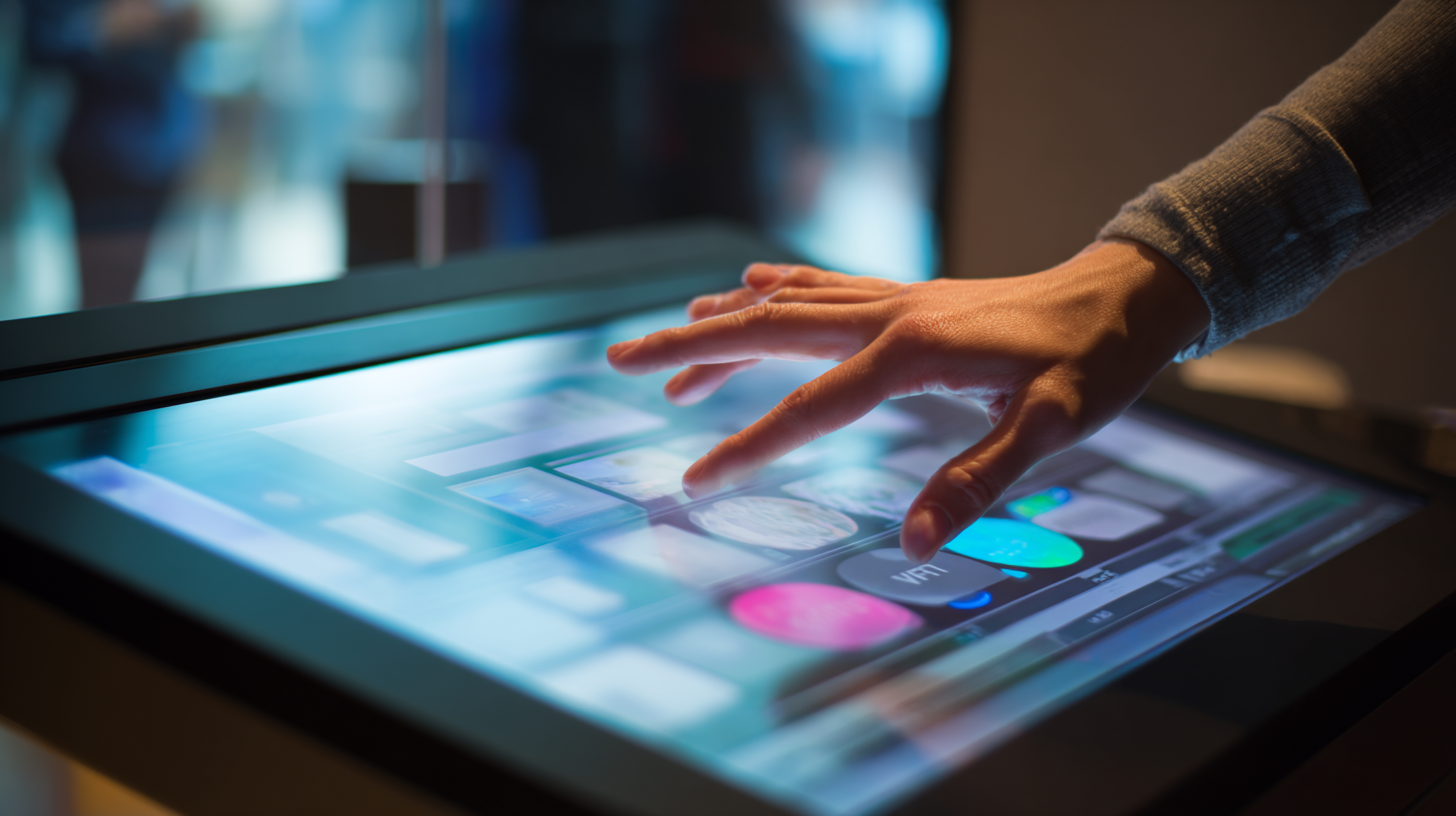How Touch Screen Monitors are Revolutionizing User Interaction in Modern Technology
The rise of touch screen monitors has fundamentally transformed user interaction across various technological platforms, enhancing both efficiency and engagement. According to a recent report by Research and Markets, the global touch screen monitor market is projected to reach $30 billion by 2026, reflecting a compound annual growth rate (CAGR) of over 10% from 2021. This surge is driven by an increasing demand for intuitive user interfaces in sectors like hospitality, retail, and healthcare, where touch screen monitors facilitate seamless interactions and improve customer experiences. Furthermore, a study by Statista revealed that more than 70% of consumers prefer touch-enabled devices due to their ease of use. As technology continues to evolve, the implementation of touch screen monitors is not only reshaping how users interact with devices but is also paving the way for innovative applications that meet the demands of a digital-first world.

Understanding the Basics of Touch Screen Technology and Its Evolution
Touch screen technology has evolved significantly since its inception in the 1970s, transitioning from resistive screens to the more advanced capacitive touch interfaces used in modern devices. According to a report by Grand View Research, the global touch screen market is projected to reach over $100 billion by 2025, largely driven by the increasing demand for interactive devices in various sectors including retail, healthcare, and education. This evolution has enabled a more intuitive interaction between users and technology, making digital experiences more accessible and engaging across different demographics.
One of the key advancements in touch screen technology is multi-touch capability, which allows users to interact with devices using multiple fingers simultaneously. This feature has transformed the way applications are designed, encouraging developers to create more interactive and user-friendly interfaces. For instance, in the gaming industry, multi-touch has led to a surge in immersive gaming experiences, as reported by Statista, with projections showing mobile gaming revenue reaching $100 billion this year.
**Tip:** When selecting a touch screen device, consider the environment in which it will be used. For example, a capacitive touch screen may be less effective in outdoor conditions where moisture or dirt can affect performance.
Another significant aspect of touch screen evolution is the integration of haptic feedback technology. This feature provides tactile responses to user interactions, enhancing the overall user experience. According to a Nielsen report, 67% of users prefer devices that offer haptic feedback, indicating its importance in modern design.
**Tip:** Always test devices for responsiveness and accuracy before purchase to ensure they meet your needs, especially in high-demand environments like retail spaces.
How Touch Screen Monitors are Revolutionizing User Interaction in Modern Technology - Understanding the Basics of Touch Screen Technology and Its Evolution
| Technology Type | Year of Introduction | Screen Size Range | Common Applications | User Interaction Techniques |
|---|---|---|---|---|
| Resistive | 1970s | 3 to 32 inches | ATMs, industrial controls | Touch and pressure |
| Capacitive | 1980s | 4 to 100 inches | Smartphones, tablets, kiosks | Multi-touch gestures |
| Infrared | 2000s | 10 to 100 inches | Interactive whiteboards, large screen TVs | Finger, stylus, and object interaction |
| Optical | 2000s | 15 to 80 inches | Interactive displays, gaming | Gestures and object detection |
Exploring Different Types of Touch Screen Monitors Available Today
The landscape of technology has been significantly enhanced by the advent of touch screen monitors, which have infiltrated various sectors, from education to healthcare and retail. According to a report by MarketsandMarkets, the global touch screen market is expected to grow from $24.86 billion in 2022 to $53.4 billion by 2027, at a compound annual growth rate (CAGR) of 16.7%. This growth indicates a shift in user interaction paradigms, with touch screens at the forefront of facilitating more intuitive engagements with technology.
Today, the market offers several types of touch screen monitors, including resistive, capacitive, and optical variants. Resistive touch screens, composed of multiple flexible layers, are widely used in environments demanding durability, such as kiosks and industrial settings. In contrast, capacitive touch screens are favored for their sensitivity and multi-touch capabilities, making them ideal for smartphones and tablets. Furthermore, optical touch screens, which utilize cameras to detect touch, are gaining traction in larger displays, often seen in interactive whiteboards and digital signage. Collectively, these technologies are not just improving user experience but are also transforming how we interact with digital content across various platforms.
Types of Touch Screen Monitors and Their Market Share in 2023
Best Practices for Optimizing User Experience with Touch Screen Interfaces
The rise of touch screen monitors has significantly transformed user interaction, but optimizing user experience through best practices is essential for maximizing their impact. A recent report highlights that 88% of online consumers are less likely to return to a site after a bad experience. This emphasizes the necessity for touch interfaces to prioritize simplicity and clarity.
 By implementing responsive design principles, touch screens can enhance usability across various devices, ensuring users encounter an intuitive layout that adapts seamlessly to their interactions.
By implementing responsive design principles, touch screens can enhance usability across various devices, ensuring users encounter an intuitive layout that adapts seamlessly to their interactions.
In addition to responsiveness, accessibility remains a critical factor in the design of touch interfaces. Research shows that over 15% of the global population experience some form of disability, thus making inclusive design practices vital. Touch screen designers should focus on clear labeling, adequate touch targets, and gesture-based navigation that accommodate different user abilities.
As indicated in industry studies, optimizing these aspects not only boosts user satisfaction but also leads to increased engagement, proving that thoughtful integration of user experience principles can significantly elevate the functionality of touch screen interfaces in modern technology.
Integrating Touch Screen Monitors in Various Industries and Applications
 Touch screen monitors have become a transformative force across various industries, enhancing user interaction in ways that were previously unimaginable. In retail, for instance, touch screen kiosks allow customers to browse products, check prices, and place orders, streamlining the shopping experience. This tactile engagement not only empowers consumers but also enables retailers to collect valuable data on purchasing behaviors, ultimately improving service offerings.
Touch screen monitors have become a transformative force across various industries, enhancing user interaction in ways that were previously unimaginable. In retail, for instance, touch screen kiosks allow customers to browse products, check prices, and place orders, streamlining the shopping experience. This tactile engagement not only empowers consumers but also enables retailers to collect valuable data on purchasing behaviors, ultimately improving service offerings.
In the healthcare sector, touch screen monitors are being utilized in patient management systems, facilitating easier access to medical records and enhancing communication between healthcare providers and patients. Medical professionals can quickly input data, view patient histories, and even demonstrate treatment options directly on the screen, making consultations more interactive and informed. Furthermore, the education industry has embraced these technologies in classrooms, where interactive whiteboards enable students to participate in lessons actively, fostering an innovative learning environment that caters to diverse learning styles.
Evaluating the Future Trends of Touch Screen Interaction in Technology
The evolution of touch screen interaction has fundamentally transformed user experiences across various technological domains. As we move into an era driven by artificial intelligence and immersive applications, the future trends of touch screen technology are poised to integrate even deeper into everyday life. One key trend is the development of haptic feedback systems that not only detect touch but also simulate the sense of touch through vibrations and motions. This advancement will enhance user engagement, making interactions more intuitive and realistic, especially in applications like virtual reality and gaming.
Another significant trend is the incorporation of multi-touch capabilities alongside gesture recognition. This technology allows users to manipulate digital environments more fluidly, employing natural movements akin to those in the physical world. Such advancements encourage creativity and efficiency, making tasks like design, gaming, and remote collaboration more interactive and productive. As touch screen monitors continue to evolve, their role as an interface for human-computer interaction will become even more crucial, paving the way for smarter, more adaptive technologies that respond seamlessly to user input.


